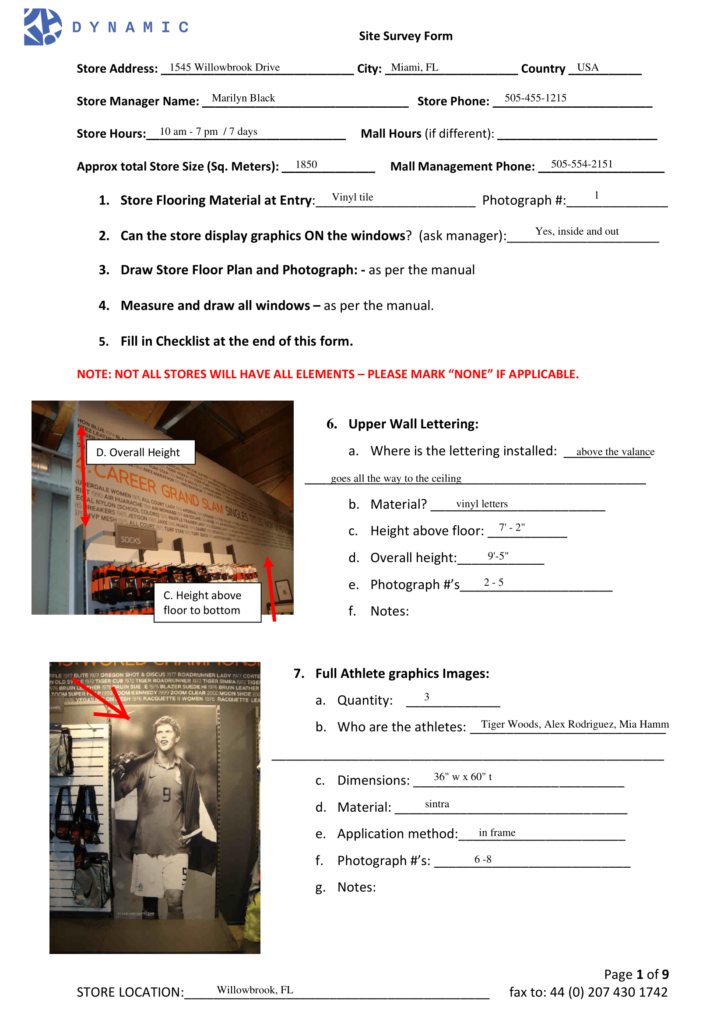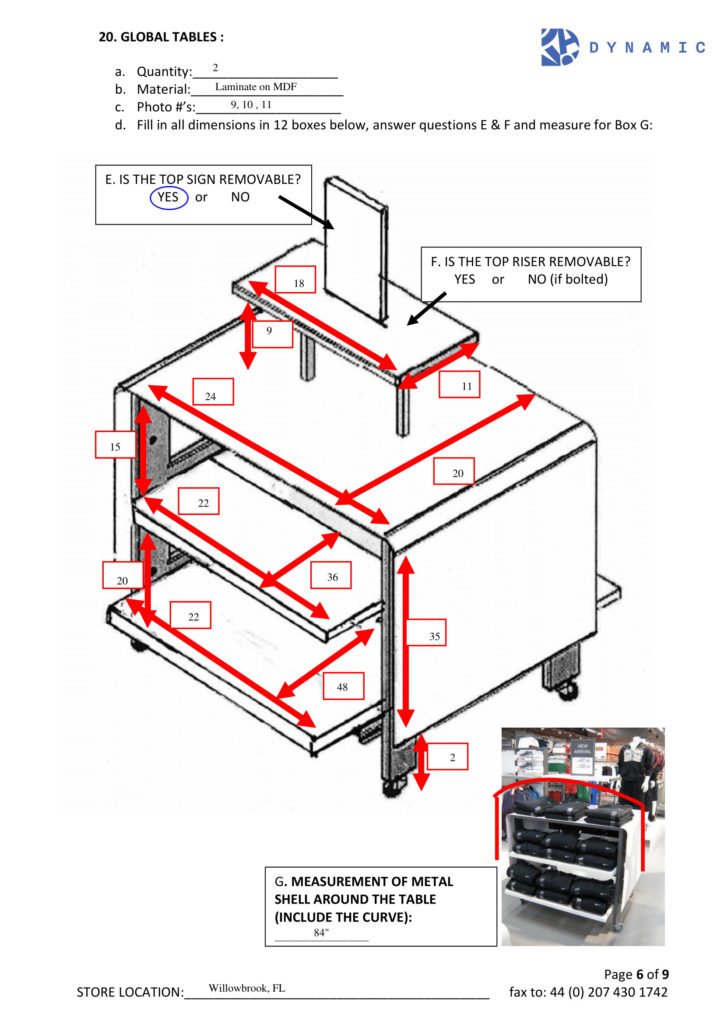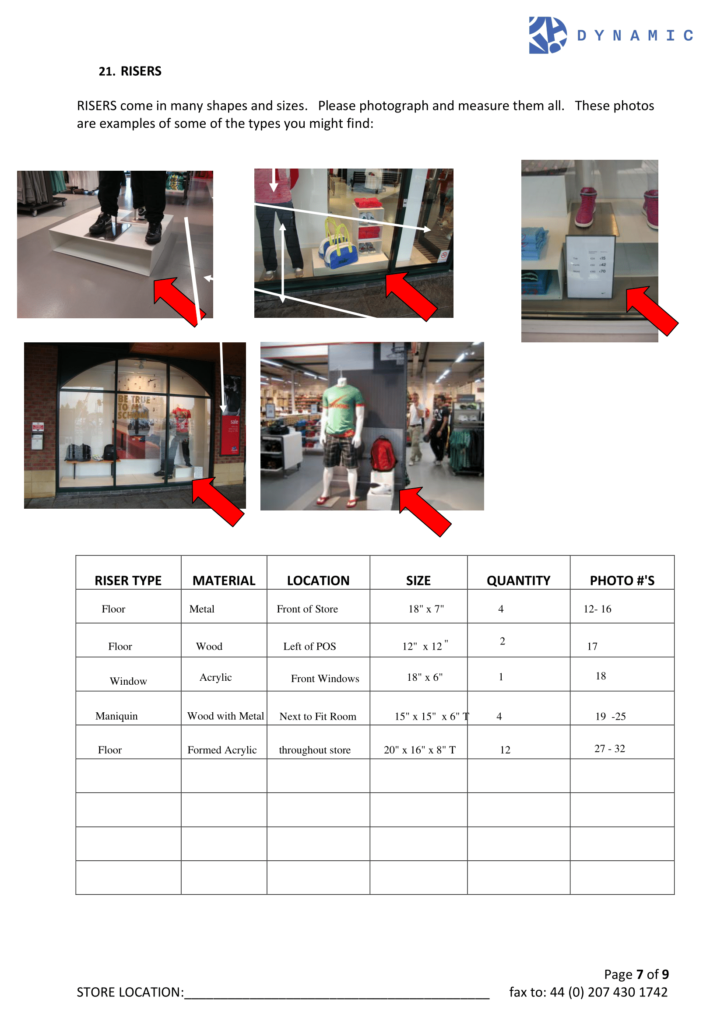The 6 essential retail field audits every store should use
If it’s part of your brick-and-mortar store—you need to know the details.
This is the power, flexibility, and value of a retail field audit.
A retail field audit gives you eyes in every single store in your retail operations. Use a retail field audit to measure, count, verify, and assess everything in your store.
There is no limit to what can be counted, measured, tested, and checked.
- Are franchisees complying with your latest display guidelines?
- What are the dimensions of your change rooms? You need to know this to order new mirrors.
- What is the depth and height of every store window in each store located in a mall?
- How many overhead lights are you using? Do any stores have burnt out lightbulbs?
Yes, it may seem endless, but this is the gold of a retail field audit.
You get access to unlimited data about every aspect of your retail store—regardless of their locations and number.
The Power and Value of Retail Audits, Data Collection, and Retail Surveys
Your retail installation team calls you to double-check the dimensions of your five stores in New York, but you can’t find the email with this information.
Your graphic designer wants to verify the height and width of the middle window facing the south side of the street—you have no idea.
This is the power and value of retail field audits, data collection, and retail surveys. You have the answers to these questions and more readily accessible in a searchable, sortable, and easy-to-use app.
Imagine having this information and more available 24/7/365:
- Ceiling heights
- Number, dimension, and precise locations of each window
- Baseboard heights
- Signage types and locations
- Type and number of overhead lights
- Dimensions of changeroom mirrors
- Depth of glass display table
- Entrance width
- Checkout counter depth and height
- Storage room dimensions and fixture details
You can easily answer any question, make informed decisions, take action, and optimize your retail space to its full capacity.
We collect this data and more for you using a range of field audits and retail survey types including:
- Retail Field and Site Audits: are non-drawing data collections and checklists of information about your retail space such as store layout details, fixture and millwork dimensions and locations, product placement, visual merchandising, and store branding compliance.
- As-Built or Architectural Surveys: document the physical layout, dimensions, and structural elements of a space to ensure accuracy in planning, design, and construction.
- Matterport Surveys: an interactive digital walkthrough of your retail stores, allowing you to virtually explore and see a location on your computer, phone, or tablet without being physically present.
- Interior Surveys: a precise measurement and documentation of the internal layout, including walls, ceilings, fixtures, and mechanical systems, to support space planning, renovations, and retail installations.
- Fixture Verification Surveys: confirm the presence and condition of fixtures in your retail space, ensuring all fixtures and millwork are installed, functioning, and maintained as planned.
- Asset Tracking Surveys: involve cataloging and verifying the location and condition of assets within your retail store, helping you maintain accurate records and counts of items such as number of chairs, types of signage, promotional materials, or number of POS units.
- Space Planning Surveys: help you understand and analyze how retail fixtures, layout, and visual merchandising can be used to optimize your space for efficiency, customer experience, and functionality.
- Compliance and Marketing Surveys: verify that your retail spaces comply with any variable you want to measure, such as the use of marketing and promotional materials, safety compliance, building code adherence, accessibility standards, and more.
Knowledge is power and the more accurate data you have about your retail stores, the easier it is for you to make informed decisions.
What is a Retail Field Audit?
A retail field audit is a non-drawing data collection of information about your retail store or the items in your retail store.
A retail field audit is used to measure, assess, track, count, verify, or learn about anything in or about your store.
For example, use a retail field audit to assess the condition of the fixtures and millwork in your store. Or use a field audit to check compliance with corporate directives, including verifying your branding is displayed properly or the visual merchandising complies with your design and display guidelines.
The data we collect during your retail field audit is available 24/7/365 in an easy-to-use, searchable, and sortable app. This allows you, for example, to click on your Miami store and see all the data and photos we’ve collected and then compare this to your New York or Scottsdale stores.
Recently, a global sporting goods brand needed to verify how their branded signage and marketing was installed and displayed in North America. They hired us to do a visual inventory audit of their stores.
We took photos and detailed measurements including details on the height, placement, materials, and application method of each branding item in every single store. Additionally, we collected data on every riser used in their stores, including full dimensions, locations, and photos of how the risers are used.
With this information, this global sporting goods brand was able to both ensure compliance with brand standards and deliver and install any missing items.



6 Types of Retail Field Audits You Need to Know About
These 6 core retail field audit types give you essential data and real-time feedback about your retail stores:
- Fixture Verification Survey
Assess, verify, count, and document the types, condition, dimensions, and placement of your fixtures and millwork. Trust this field audit to ensure your shelves, seating, displays, racks, and other store fixtures are installed, functioning, and maintained as planned.
The information collected in a fixture verification survey is valuable for visual merchandising, planning store layouts, and preventing cost overruns during store renovations or new openings. - Operational Audits
Evaluate and optimize the efficiency and effectiveness of your store operations. Collect data on inventory management, visual merchandising, customer service, and sales processes.
Optimize product placement, verify adherence to planograms and display guidelines, and ensure the correct use of promotional and branding displays. Understand how your retail design can be improved to eliminate customer service and sales challenges. - Retail Accessibility Survey
Ensure your retail stores offer an inclusive and accessible environment, meeting people of all needs including those with mobility, vision, hearing, sensory, physical, or neurodiversity needs.
An accessibility survey can be used to collect data on entranceway and exits, aisle widths, shelving and display access and placement, lighting, signage and navigation, checkout and payment terminal design, and more. - Visual Merchandising Audit
A visual merchandising audit evaluates store displays, signage, layout, and overall vibe to ensure alignment with your brand identity, sales goals, and customer expectations.
For example, ask us to verify that all window displays, graphics, and signage conform to your brand and promotional guidelines, we can take photos and measurements that you can use to update and refresh these key merchandising assets. - Campaign and Promotion Audit
Because you can’t be in all your stores, it’s difficult to ensure that your campaign and promotional displays are implemented correctly.
During this audit, we visit all your stores to make sure your compliance materials are displayed in the right locations and are current. Using a checklist on our app, we ensure your franchisees, store owners, and dealers are following your guidelines.
Knowing this information helps you understand why or why not a recent promotion succeeded in one location and not another—it could simply be a matter of incorrect promotional material placement. - Health and Safety Audit
Ensure your stores are compliant with all health and safety requirements including, emergency exit signage, unobstructed store aisles and pathways, first aid kits availability, and adherence to store safety policies.
The Dollars and Sense Benefits of Retail Field Audits
The benefits of retail field audits add up, converting to lowered total cost of ownership, improved sales, better brand awareness and loyalty, and better looking and functioning retail stores:
- Improved operational efficiency: retail field audits help identify gaps and areas for improvement in store layout and design, inventory management, staffing, and customer experience.
For example, a fashion retailer used a retail field audit to learn how their stores were displaying key seasonal clothing items. This audit revealed that some stores with lower sales figures were slow to display seasonal items, resulting in lost sales and inventory management challenges. - Cost savings and sales growth: optimizing visual merchandising, ensuring correct campaign and promotional material displays, and customer-friendly store layout translates to better customer experiences, brand awareness and loyalty, and improved sales.
For example, a car and SUV manufacturer conducts twice yearly campaign and promotional audits to ensure promotional signage is installed and displayed correctly in their dealerships. Because this signage is tied directly to manufacturer promotions, interest rates, and brand awareness, it’s vital there is a consistent message across all dealerships. - Data-driven decision making: rely on the quantitative and object data collected during retail field audits to give you facts you need to make informed decisions around productization, marketing, and retail design and installation.
For example, a national sporting goods brand used a fixture verification survey to learn how their graphics and signs are installed in their stores. This brand differentiates itself with retail design, fixtures, millwork, and branding unique to each city and location, giving people a “hometown” feeling in their stores. With the data collected from the survey, the brand was able to design new graphics and signs that fit seamlessly within each store’s unique layout and design. - Continuous improvement: implement best practices around store maintenance, campaign and promotional display adherence, visual merchandising, and customer service to create a more consistent and high-quality experience across all store locations.
For example, a national coffee shop brand uses visual merchandising audits to collect data on available wall space, including dimensions, adjacent shelving or displays, and location of outlets. With this information the coffee shop brand works with their marketing and branding team to create new in-store decorations such as murals, green walls, and art installations. - Strategic brand management: as a brand it is critical you understand how your products are displayed and marketed. Use retail field audit data to ensure compliance with your brand standards and to adjust your marketing strategies to ensure optimal brand awareness.
For example, an international shoe and sports apparel brand uses quarterly fixture verification surveys to ensure all kiosks, risers, and display tables are installed in accordance with brand guidelines.
Do not overlook the power of proactive retail field audits:
- Learn why your latest promotion is falling flat in some cities (hint: some managers haven’t bothered to display the new signage).
- Understand why your store managers aren’t using your latest window graphic (hint: they’re the wrong size).
- Have the answers to the questions your retail design team is asking (hint: they really do need to know how many outlets there are and the height from the floor).
And no, the notes you took in 2022 when you renovated are not helpful. In fact, we can guarantee they’re inaccurate and will end up costing you more money.
Unlock opportunity. Find areas for improvement. Make decisions based on real, verifiable data. Do not leave your retail success to chance. Take advantage of the power of retail field audits.
At Dynamic, our unique combination of IN-HOUSE offerings makes us your single source provider for all your retail field audits, survey, design, planning, installation, and construction needs. No one understands retail installation better than we do.
Contact us to learn how we handle any aspect of your business–from an individual retail store to a global roll out. We are here for you.
